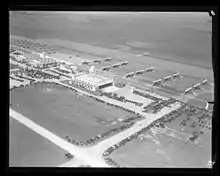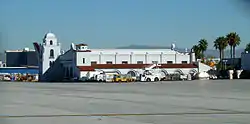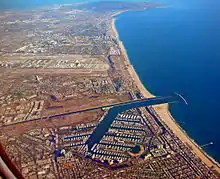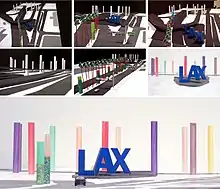History of Los Angeles International Airport
Los Angeles International Airport is a major American airport in the United States that was constructed in 1928.[1]
1920-1929



In 1928, the Los Angeles City Council selected 640 acres (1.00 sq mi; 260 ha) in the southern part of Westchester for a new airport for the city. The fields of wheat, barley and lima beans were converted into dirt landing strips without any terminal buildings. It was named Mines Field for William W. Mines, the real estate agent who arranged the deal.[1] The first structure, Hangar No. 1, was erected in 1929 and is in the National Register of Historic Places.[3]
1930–1999
Mines Field opened as the airport of Los Angeles in 1930 and the city purchased it to be a municipal airfield in 1937. The name became Los Angeles Airport in 1941 and Los Angeles International Airport in 1949.[4] In the 1930s the main airline airports were Burbank Airport (then known as Union Air Terminal, and later Lockheed) in Burbank and the Grand Central Airport in Glendale. (In 1940 the airlines were all at Burbank except for Mexicana's three departures a week from Glendale; in late 1946 most airline flights moved to LAX, but Burbank always retained a few.)[5]
Mines Field did not extend west of Sepulveda Boulevard;[6] Sepulveda was rerouted circa 1950 to loop around the west ends of the extended east–west runways (now runways 25L and 25R), which by November 1950 were 6,000 feet (1,800 m) long.[7] A tunnel was completed in 1953 allowing Sepulveda Boulevard to revert to straight and pass beneath the two runways; it was the first tunnel of its kind. For the next few years the two runways were 8,500 feet (2,600 m) long.[4][8]
On July 10, 1956, Boeing's 707 prototype (the 367–80) visited LAX. The Los Angeles Times said it was its first appearance at a "commercial airport" outside the Seattle area.[9]
The April 1957 Official Airline Guide showed 66 weekday departures on United Airlines, 32 American Airlines, 32 Western Airlines, 27 TWA, nine Southwest, five Bonanza Air Lines and three Mexicana Airlines; also 22 flights a week on Pan American World Airways and five a week on Scandinavian Airlines (the only direct flights from California to Europe).
American Airlines' 707-123s flew the first jet passengers out of LAX to New York in January 1959; the first wide-body jets were TWA's Boeing 747s to New York in early 1970.[4]
In 1958, the architecture firm Pereira & Luckman was contracted to plan the re-design of the airport for the "jet age". The plan, developed with architects Welton Becket and Paul Williams, called for a series of terminals and parking structures in the central portion of the property, with these buildings connected at the center by a huge steel-and-glass dome. The dome was never built but the Theme Building built in the central area became a focal point visible to people coming to the airport.
In the new terminal area west of Sepulveda Blvd that started opening in 1961, each terminal had a satellite building out in the middle of the ramp, reached by tunnels from the ticketing area.[10] United's satellites 7 and 8 were first to open, followed by TWA's terminal 3, American's terminal 4 and Western's terminal 5. Satellite 2 opened as the international terminal several months later, and satellite 6, a "consolidated" terminal for other domestic carriers, was to be the last to open.[11][12] By 1964 the airport had international service by Aeronaves, Air France, JAL, TWA, UTA, Varig and Western in addition to Mexicana, Pan Am and SAS.[13]
Since the 1920s, a neighborhood called Surfridge had been on the coastline west of the airport, part of the larger community of Palisades del Rey along with the neighborhood to the north now known as Playa del Rey. When the airlines switched to jet airliners during the 1960s and 1970s and Surfridge's residents complained about noise pollution, the city used its eminent domain powers to condemn and evacuate Surfridge. The government bulldozed the homes but did not bulldoze the streets, and the fenced-off "ghost" streets west of LAX are still there.
In 1981, LAX began a $700 million expansion in preparation for the 1984 Summer Olympics. The U-shaped roadway past the terminal entrances got a second level, with arriving passengers on the lower level and departing on the upper. Connector buildings between the ticketing areas and the satellite buildings were added, changing the layout to a "pier" design. Two new terminals (Terminal 1 and the Tom Bradley International Terminal) were built and Terminal 2, then two decades old, was rebuilt. Multi-story parking structures were also built in the center of the airport.[4]
On July 8, 1982, groundbreaking for the two new terminals were conducted by Mayor Tom Bradley and World War II aviator General James Doolittle. The $123 million 963,000-square-foot (89,500 m2) International Terminal opened on June 11, 1984, and was named for Bradley.[4]
Starting in the mid-1990s, under Mayors Richard Riordan and James Hahn, modernization and expansion plans for LAX were prepared, only to be stymied by a coalition of residents who live near the airport. They cited increased noise, pollution and traffic impacts of the project.
On April 29, 1992, the airport closed for violence and cleanup after the 1992 Los Angeles Riots over the Rodney King beating.
The airport closed again as a 2-hour pre-caution on January 17, 1994 after the Northridge earthquake.
In 1996, a $29 million, 277-foot-tall (84 m) air traffic control tower was built near the Theme Building.[4][14]
2000–Present
In 2000, the LAX Beautification Design Team,[15] who included LA artists, Paul Tzanetopoulos and Selbert Perkins Design in collaboration with Ted Tokio Tanaka Architects[16] designed a major public art kinetic light installation for the perimeter of the airport, LAX Gateway Pylons, consisting of free-standing translucent, internally-lit glass columns.[17][15]

The installation consists of a 32-foot high "LAX" signage sculpture, a corridor of eleven 25-60-foot pylons, and a circle of fifteen 100-foot by 12-foot pylons.[15] This new public art installation at the airport entrance offered a welcoming landmark for visitors.[16] The entire sculpture ascends 1 mile, starting from the smallest light tower (25 ft) at Century Blvd. and Bellanca Ave. and culminating at the "halo" of columns (100 ft.) that surround the "knot" at the entrance of LAX. The LAX Gateway Pylons underwent improvements in 2006, including replacement of stage lighting inside the cylinders with LED lights to conserve energy, facilitate maintenance, and enable on-demand cycling through various color effects.[18]
In late 2005, newly elected Mayor Antonio Villaraigosa was able to reach a compromise, allowing some modernization to go forward while encouraging future growth among other facilities in the region.
It is illegal to limit the number of passengers that use an airport, but in December 2005 the city agreed to limit the passenger gates to 163. Once passenger usage hits 75 million, a maximum of two gates a year for up to five years will be closed, intending to limit growth to 79 million passengers a year. In exchange civil lawsuits were abandoned, to allow the city to complete badly needed improvements to the airport.[19]
In 2008, plans were unveiled for a $4.11 billion renovation and improvement program to expand and rehabilitate the Tom Bradley International Terminal to accommodate the next generation of larger aircraft, as well as handle the growing number of flights to and from the Southern California region, and to develop the Central Terminal Area (CTA) of the airport to include streamlined passenger processing, public transportation and updated central utility plants.[20] As of 2013, Los Angeles International Airport is the biggest airport in California. The multi-year project, originally projected to be completed in 2014, is ongoing as of February 2015,[21] and is the largest public works project in Los Angeles history.[22][23] On February 27, 2017, airport officials announced the $1.6-billion Midfield Satellite Concourse that will be an expansion of Tom Bradley International Terminal as part of the $14-billion improvement program.[24]
References
- "LAX Early History". Los Angeles World Airports. Archived from the original on September 27, 2011. Retrieved October 25, 2011.
- "Aviation Facilities Company, Inc.: Properties: LAX". Afcoinc.com. Archived from the original on July 7, 2011. Retrieved December 6, 2010.
- "LAX – Airport Information – General Description". Lawa.org. Retrieved December 6, 2010.
- "Search history". Los Angeles World Airports. Archived from the original on 2005-09-24. Retrieved March 21, 2008.
- Official Guide of the Airways 7/40 and American Aviation Air Traffic Guide 1/46, 12/46 and 6/47
- "backwards 1939 aerial view". Digitallibrary.usc.edu. Retrieved August 13, 2013.
- "USC Libraries Digital Collections". Digitallibrary.usc.edu. Retrieved 2016-04-28.
- Airport diagrams for 1956 and 1965
- "Planes". Index of /. Retrieved November 1, 2013.
- Nelson, Valerie J. (November 25, 2007). "Charles D. Kratka, 85; designer, artist created mosaic tunnel walls at LAX". Los Angeles Times.
- Aviation Week July 3, 1961 p40
- "Terminal area map from about 1961". Flickr.com. Retrieved August 13, 2013.
- "LAX64". www.departedflights.com. Retrieved 2018-01-19.
- Reynolds, Christopher (June 12, 2018). "Is LAX's Theme Building coming back to life as part of an on-airport hotel?". Los Angeles Times. Retrieved June 13, 2019.
- T. JARVIS, MICHAEL (19 November 2000). "The Real L.A. Luminaries". LA Times. Retrieved 4 September 2020.
- "Design Firm: Selbert Perkins Design Client: LA World Airports". SEGD.org. SEGD.
- Tsanetopoulos, Paul (2020). "LAX - Kinetic Light Installation". Paul Tsanetopoulos - Public Art. Retrieved May 15, 2020.
- "Story About the Kinetic Light Installation at the Los Angeles International Airport". SeeTheGlobe.com. October 20, 2007. Retrieved July 31, 2009.
- "Deal Cut to Halt Los Angeles Airport Lawsuits". Archived from the original on July 22, 2010.
- Lubell, Sam (November 26, 2008). "Re-LAX – LA International Airport unveils ambitious expansion plans". The Architect's Newspaper. Archived from the original on April 17, 2014.
- "February construction projects may cause passenger impacts". Los Angeles World Airports. February 3, 2015. Archived from the original on February 3, 2015.
- "Los Angeles International Airport in 2011 – Economic Impact Analysis" (PDF). Los Angeles County Economic Development Corporation. August 2012. Retrieved February 3, 2015.
- "The New Tom Bradley International Terminal Project Fact Sheet" (PDF). Retrieved March 23, 2013.
- Cota-Robles, Marc (2017-02-27). "Construction of $1.6B LAX concourse kicks off at ceremony". ABC7 Los Angeles. Retrieved 2017-02-27.
